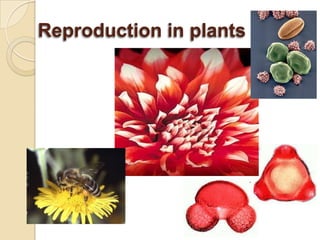Reproduction in plants
•Télécharger en tant que PPTX, PDF•
68 j'aime•77,572 vues
For IGCSE O-Level Biology students Chapter 13
Signaler
Partager
Signaler
Partager

Contenu connexe
Tendances (20)
En vedette
En vedette (20)
NEW STANDARDS 6th grade Plants1: classification & processes

NEW STANDARDS 6th grade Plants1: classification & processes
How to Craft Your Company's Storytelling Voice by Ann Handley of MarketingProfs

How to Craft Your Company's Storytelling Voice by Ann Handley of MarketingProfs
What REALLY Differentiates The Best Content Marketers From The Rest

What REALLY Differentiates The Best Content Marketers From The Rest
20 Tweetable Quotes to Inspire Marketing & Design Creative Genius

20 Tweetable Quotes to Inspire Marketing & Design Creative Genius
40 Tools in 20 Minutes: Hacking your Marketing Career

40 Tools in 20 Minutes: Hacking your Marketing Career
What 33 Successful Entrepreneurs Learned From Failure

What 33 Successful Entrepreneurs Learned From Failure
Similaire à Reproduction in plants
Reproduction in flowering plants (sexual reproduction)

Reproduction in flowering plants (sexual reproduction)Shashi kumari,Delhi university,Amity university,JNU New Delhi
Similaire à Reproduction in plants (20)
reproductioninplants-140319174523-phpapp01 (1).pptx

reproductioninplants-140319174523-phpapp01 (1).pptx
reproductioninplants-140319174523-phpapp01 (1).pptx

reproductioninplants-140319174523-phpapp01 (1).pptx
Reproduction in flowering plants (sexual reproduction)

Reproduction in flowering plants (sexual reproduction)
1. materi science p5 ws 1 reproduction vegetatif of naturally

1. materi science p5 ws 1 reproduction vegetatif of naturally
Plus de Ruba Salah
Plus de Ruba Salah (20)
Dernier
Explore beautiful and ugly buildings. Mathematics helps us create beautiful d...

Explore beautiful and ugly buildings. Mathematics helps us create beautiful d...christianmathematics
Dernier (20)
Seal of Good Local Governance (SGLG) 2024Final.pptx

Seal of Good Local Governance (SGLG) 2024Final.pptx
Ecological Succession. ( ECOSYSTEM, B. Pharmacy, 1st Year, Sem-II, Environmen...

Ecological Succession. ( ECOSYSTEM, B. Pharmacy, 1st Year, Sem-II, Environmen...
Web & Social Media Analytics Previous Year Question Paper.pdf

Web & Social Media Analytics Previous Year Question Paper.pdf
Z Score,T Score, Percential Rank and Box Plot Graph

Z Score,T Score, Percential Rank and Box Plot Graph
Explore beautiful and ugly buildings. Mathematics helps us create beautiful d...

Explore beautiful and ugly buildings. Mathematics helps us create beautiful d...
Food Chain and Food Web (Ecosystem) EVS, B. Pharmacy 1st Year, Sem-II

Food Chain and Food Web (Ecosystem) EVS, B. Pharmacy 1st Year, Sem-II
Presentation by Andreas Schleicher Tackling the School Absenteeism Crisis 30 ...

Presentation by Andreas Schleicher Tackling the School Absenteeism Crisis 30 ...
Unit-IV; Professional Sales Representative (PSR).pptx

Unit-IV; Professional Sales Representative (PSR).pptx
Reproduction in plants
- 2. Sexual & asexual reproduction Sexual reproduction: Two parents Fusion of a female & male cells (gametes) Parent & offspring are not identical Slower Variation is present in the same species Asexual reproduction: One parent only No gametes are produced Parent and offspring are identical Faster No variation
- 3. Examples of asexual reproduction. Budding in yeast Nucleus replicates Nucleus migrates to one end Part of the cell grows into a bud The bud separates creating a new cell
- 4. Examples of asexual reproduction. Vegetative reproduction in potato plants
- 5. Examples of asexual reproduction. Runners in strawberry
- 6. Sexual reproduction in plants To reproduce sexually plants have male and female reproductive organs in their flowers. The male part is called the stamen The female part is called the carpel
- 10. POLLINATION It is the transfer of pollen grains from the anthers to the stigma Pollinating agents Insects Wind
- 11. Differences between insect & wind pollinated flowers Insect pollinated Wind pollinated Have large colored petals with guide lines Have a scent Have a nectary on which insects feed Have a sticky stigma for pollen grains to stick on it The female and male organs are enclosed in the flower Pollen grains are larger with spikes to hold on insect body Have small green petals, no guide lines Have no scent Have no nectary Have a feathery stigma to catch the pollen in the air The female and male organs are hanging outside the flower Pollen grains are smaller & light weight to be carried by wind
- 12. POLLEN GRAINS AS SEEN UNDER THE MICROSCOPE Can you tell which belongs to insect pollinated flowers / wind pollinated flowers?
- 13. FERTILISATION It is the joining of male and female cells to produce a zygote. Ovary Fruit Ovary wall Fruit cover Ovule Seed
- 14. Seed structure D
- 15. Seed-fruit dispersal If a seed lands next to the parent plant and germinates it will compete with the parent plant for nutrients in the soil. Most plants developed methods to scatter/disperse their seeds to ensure they land further away from the original plant. There are 2 main methods of seed dispersal: Wind dispersal Animal dispersal
- 16. Wind dispersal Parachute e.g. dandelion Winged fruits e.g. Acer
- 17. Animal dispersal Hooked fruits e.g. Burdock and others
- 18. Animal dispersal Other fruits are large coloured and fleshy/juicy to attract animals to eat them, swallowing the seeds at the same time. The seeds have hard indigestible testa that pass out with faeces in a new area away from original plant. Example of such fruits: apple, acorn, strawberries…etc.
- 19. Seed germination Once a seed falls onto a suitable surface it starts to grow. Conditions required for seed germination: 1. Suitable temperature 2. Oxygen 3. Water
